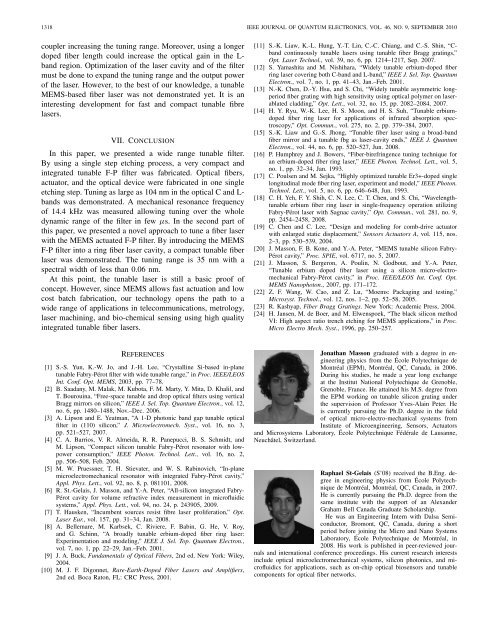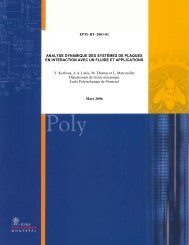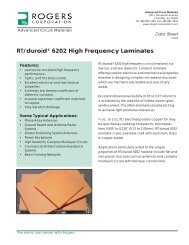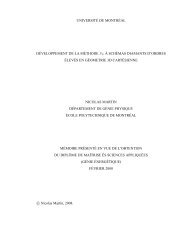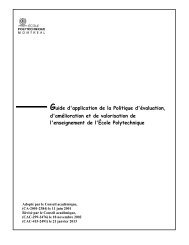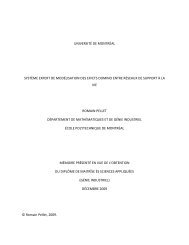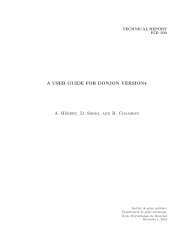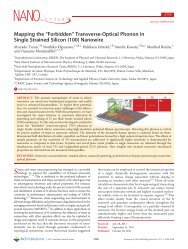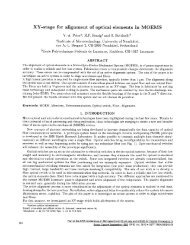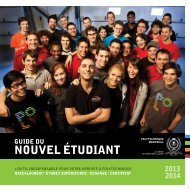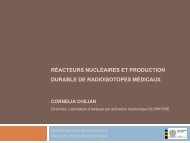Tunable Fiber Laser Using a MEMS-Based In Plane ... - ResearchGate
Tunable Fiber Laser Using a MEMS-Based In Plane ... - ResearchGate
Tunable Fiber Laser Using a MEMS-Based In Plane ... - ResearchGate
You also want an ePaper? Increase the reach of your titles
YUMPU automatically turns print PDFs into web optimized ePapers that Google loves.
1318 IEEE JOURNAL OF QUANTUM ELECTRONICS, VOL. 46, NO. 9, SEPTEMBER 2010<br />
coupler increasing the tuning range. Moreover, using a longer<br />
doped fiber length could increase the optical gain in the L-<br />
band region. Optimization of the laser cavity and of the filter<br />
must be done to expand the tuning range and the output power<br />
of the laser. However, to the best of our knowledge, a tunable<br />
<strong>MEMS</strong>-based fiber laser was not demonstrated yet. It is an<br />
interesting development for fast and compact tunable fibre<br />
lasers.<br />
VII. Conclusion<br />
<strong>In</strong> this paper, we presented a wide range tunable filter.<br />
By using a single step etching process, a very compact and<br />
integrated tunable F-P filter was fabricated. Optical fibers,<br />
actuator, and the optical device were fabricated in one single<br />
etching step. Tuning as large as 104 nm in the optical C and L-<br />
bands was demonstrated. A mechanical resonance frequency<br />
of 14.4 kHz was measured allowing tuning over the whole<br />
dynamic range of the filter in few µs. <strong>In</strong> the second part of<br />
this paper, we presented a novel approach to tune a fiber laser<br />
with the <strong>MEMS</strong> actuated F-P filter. By introducing the <strong>MEMS</strong><br />
F-P filter into a ring fiber laser cavity, a compact tunable fiber<br />
laser was demonstrated. The tuning range is 35 nm with a<br />
spectral width of less than 0.06 nm.<br />
At this point, the tunable laser is still a basic proof of<br />
concept. However, since <strong>MEMS</strong> allows fast actuation and low<br />
cost batch fabrication, our technology opens the path to a<br />
wide range of applications in telecommunications, metrology,<br />
laser machining, and bio-chemical sensing using high quality<br />
integrated tunable fiber lasers.<br />
[11] S.-K. Liaw, K.-L. Hung, Y.-T. Lin, C.-C. Chiang, and C.-S. Shin, “Cband<br />
continuously tunable lasers using tunable fiber Bragg gratings,”<br />
Opt. <strong>Laser</strong> Technol., vol. 39, no. 6, pp. 1214–1217, Sep. 2007.<br />
[12] S. Yamashita and M. Nishihara, “Widely tunable erbium-doped fiber<br />
ring laser covering both C-band and L-band,” IEEE J. Sel. Top. Quantum<br />
Electron., vol. 7, no. 1, pp. 41–43, Jan.–Feb. 2001.<br />
[13] N.-K. Chen, D.-Y. Hsu, and S. Chi, “Widely tunable asymmetric longperiod<br />
fiber grating with high sensitivity using optical polymer on laserablated<br />
cladding,” Opt. Lett., vol. 32, no. 15, pp. 2082–2084, 2007.<br />
[14] H. Y. Ryu, W.-K. Lee, H. S. Moon, and H. S. Suh, “<strong>Tunable</strong> erbiumdoped<br />
fiber ring laser for applications of infrared absorption spectroscopy,”<br />
Opt. Commun., vol. 275, no. 2, pp. 379–384, 2007.<br />
[15] S.-K. Liaw and G.-S. Jhong, “<strong>Tunable</strong> fiber laser using a broad-band<br />
fiber mirror and a tunable fbg as laser-cavity ends,” IEEE J. Quantum<br />
Electron., vol. 44, no. 6, pp. 520–527, Jun. 2008.<br />
[16] P. Humphrey and J. Bowers, “<strong>Fiber</strong>-birefringence tuning technique for<br />
an erbium-doped fiber ring laser,” IEEE Photon. Technol. Lett., vol. 5,<br />
no. 1, pp. 32–34, Jan. 1993.<br />
[17] C. Poulsen and M. Sejka, “Highly optimized tunable Er3+-doped single<br />
longitudinal mode fiber ring laser, experiment and model,” IEEE Photon.<br />
Technol. Lett., vol. 5, no. 6, pp. 646–648, Jun. 1993.<br />
[18] C. H. Yeh, F. Y. Shih, C. N. Lee, C. T. Chen, and S. Chi, “Wavelengthtunable<br />
erbium fiber ring laser in single-frequency operation utilizing<br />
Fabry-Pérot laser with Sagnac cavity,” Opt. Commun., vol. 281, no. 9,<br />
pp. 2454–2458, 2008.<br />
[19] C. Chen and C. Lee, “Design and modeling for comb-drive actuator<br />
with enlarged static displacement,” Sensors Actuators A, vol. 115, nos.<br />
2–3, pp. 530–539, 2004.<br />
[20] J. Masson, F. B. Kone, and Y.-A. Peter, “<strong>MEMS</strong> tunable silicon Fabry-<br />
Pérot cavity,” Proc. SPIE, vol. 6717, no. 5, 2007.<br />
[21] J. Masson, S. Bergeron, A. Poulin, N. Godbout, and Y.-A. Peter,<br />
“<strong>Tunable</strong> erbium doped fiber laser using a silicon micro-electromechanical<br />
Fabry-Pérot cavity,” in Proc. IEEE/LEOS <strong>In</strong>t. Conf. Opt.<br />
<strong>MEMS</strong> Nanophoton., 2007, pp. 171–172.<br />
[22] Z. F. Wang, W. Cao, and Z. Lu, “Moems: Packaging and testing,”<br />
Microsyst. Technol., vol. 12, nos. 1–2, pp. 52–58, 2005.<br />
[23] R. Kashyap, <strong>Fiber</strong> Bragg Gratings. New York: Academic Press, 2004.<br />
[24] H. Jansen, M. de Boer, and M. Elwenspoek, “The black silicon method<br />
VI: High aspect ratio trench etching for <strong>MEMS</strong> applications,” in Proc.<br />
Micro Electro Mech. Syst., 1996, pp. 250–257.<br />
References<br />
[1] S.-S. Yun, K.-W. Jo, and J.-H. Lee, “Crystalline Si-based in-plane<br />
tunable Fabry-Pérot filter with wide tunable range,” in Proc. IEEE/LEOS<br />
<strong>In</strong>t. Conf. Opt. <strong>MEMS</strong>, 2003, pp. 77–78.<br />
[2] B. Saadany, M. Malak, M. Kubota, F. M. Marty, Y. Mita, D. Khalil, and<br />
T. Bourouina, “Free-space tunable and drop optical filters using vertical<br />
Bragg mirrors on silicon,” IEEE J. Sel. Top. Quantum Electron., vol. 12,<br />
no. 6, pp. 1480–1488, Nov.–Dec. 2006.<br />
[3] A. Lipson and E. Yeatman, “A 1-D photonic band gap tunable optical<br />
filter in (110) silicon,” J. Microelectromech. Syst., vol. 16, no. 3,<br />
pp. 521–527, 2007.<br />
[4] C. A. Barrios, V. R. Almeida, R. R. Panepucci, B. S. Schmidt, and<br />
M. Lipson, “Compact silicon tunable Fabry-Pérot resonator with lowpower<br />
consumption,” IEEE Photon. Technol. Lett., vol. 16, no. 2,<br />
pp. 506–508, Feb. 2004.<br />
[5] M. W. Pruessner, T. H. Stievater, and W. S. Rabinovich, “<strong>In</strong>-plane<br />
microelectromechanical resonator with integrated Fabry-Pérot cavity,”<br />
Appl. Phys. Lett., vol. 92, no. 8, p. 081101, 2008.<br />
[6] R. St.-Gelais, J. Masson, and Y.-A. Peter, “All-silicon integrated Fabry-<br />
Pérot cavity for volume refractive index measurement in microfluidic<br />
systems,” Appl. Phys. Lett., vol. 94, no. 24, p. 243905, 2009.<br />
[7] T. Hausken, “<strong>In</strong>cumbent sources resist fibre laser proliferation,” Opt.<br />
<strong>Laser</strong> Eur., vol. 157, pp. 31–34, Jan. 2008.<br />
[8] A. Bellemare, M. Karbsek, C. Riviere, F. Babin, G. He, V. Roy,<br />
and G. Schinn, “A broadly tunable erbium-doped fiber ring laser:<br />
Experimentation and modeling,” IEEE J. Sel. Top. Quantum Electron.,<br />
vol. 7, no. 1, pp. 22–29, Jan.–Feb. 2001.<br />
[9] J. A. Buck, Fundamentals of Optical <strong>Fiber</strong>s, 2nd ed. New York: Wiley,<br />
2004.<br />
[10] M. J. F. Digonnet, Rare-Earth-Doped <strong>Fiber</strong> <strong>Laser</strong>s and Amplifiers,<br />
2nd ed. Boca Raton, FL: CRC Press, 2001.<br />
Jonathan Masson graduated with a degree in engineering<br />
physics from the École Polytechnique de<br />
Montréal (EPM), Montréal, QC, Canada, in 2006.<br />
During his studies, he made a year long exchange<br />
at the <strong>In</strong>stitut National Polytechique de Grenoble,<br />
Grenoble, France. He attained his M.S. degree from<br />
the EPM working on tunable silicon grating under<br />
the supervision of Professor Yves-Alain Peter. He<br />
is currently pursuing the Ph.D. degree in the field<br />
of optical micro-electro-mechanical systems from<br />
<strong>In</strong>stitute of Microengineering, Sensors, Actuators<br />
and Microsystems Laboratory, École Polytechnique Fédérale de Lausanne,<br />
Neuchâtel, Switzerland.<br />
Raphael St-Gelais (S’08) received the B.Eng. degree<br />
in engineering physics from École Polytechnique<br />
de Montréal, Montréal, QC, Canada, in 2007.<br />
He is currently pursuing the Ph.D. degree from the<br />
same institute with the support of an Alexander<br />
Graham Bell Canada Graduate Scholarship.<br />
He was an Engineering <strong>In</strong>tern with Dalsa Semiconductor,<br />
Bromont, QC, Canada, during a short<br />
period before joining the Micro and Nano Systems<br />
Laboratory, École Polytechnique de Montréal, in<br />
2008. His work is published in peer-reviewed journals<br />
and international conference proceedings. His current research interests<br />
include optical microelectromechanical systems, silicon photonics, and microfluidics<br />
for applications, such as on-chip optical biosensors and tunable<br />
components for optical fiber networks.


